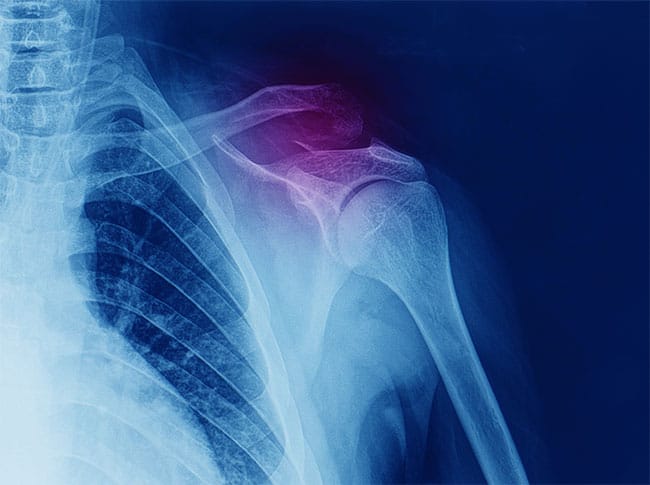Overview of the Rotator Cuff
The rotator cuff is made up of four muscles that come together as tendons and attach to the upper part of the arm bone. These four tendons assist in stabilizing the shoulder joint and performing certain movements. They are called:
- The supraspinatus
- The infraspinatus
- The subscapularis
- The teres minor

Together, these tendons form a “cuff” over the head of the humerus (upper arm bone). Any of these tendons can tear partially or completely from the bone, although the most commonly torn tendon is from the supraspinatus
How Does Rotator Cuff Injury Occur?
Vigorous physical activity or an injury can cause a tear, but some rotator cuff tendon tears happen without a clear cause. They can happen from normal wear-and-tear or because of athletic overuse or accidental overextension. For older adults or individuals with weakened tendons, even simple things like lifting an object or a routine movement can be a cause of rotator cuff injuries. Usually though, tendons are damaged through overuse or by an immense amount of force—like a sports injury or a fall.
Tendon injuries can also happen due a lack of blood supply to the rotator cuff tendons. Blood supply is essential for repairing routine wear-and-tear and other types of mild damage. Routine exercise, nutrition, a healthy lifestyle, and managing co-existing medical problems are likely to help maintain a healthy rotator cuff tendon with a good blood supply. Certain bone spurs around the tendons can also be an issue that may contribute to a rotator cuff injury.
Rotator Cuff Injury Risk Factors
Risk factors for rotator cuff injuries include:
- being over 40 years old
- a traumatic injury (eg. fall from a height, vehicle accident, difficult crash during sport such as skiing)
- repetitive activities (sports, painting, carpentry, etc.).

Rotator cuff problems increase with age. It’s common for people over the age of sixty to have some degree of tearing in their rotator cuff tendons. In fact, by age sixty, 10% or more of the population will have a full-thickness tear in their rotator cuff. By age seventy, more than 33% of people will have a tear. By age eighty, that number rises to greater than 50%. Even for folks as young as forty, it’s not considered unusual to have a partial tear. Rotator cuff tears are also more common in people who smoke or have diabetes.
When Can Rotator Cuff Tears Happen?
Rotator cuff tears happen whether a person is active or sedentary, in construction or accounting. Many people with tears have no symptoms and can live with the condition without discomfort or inconvenience. Others have troubling symptoms that need medical attention. In general, tears that occur suddenly in active patients are usually best treated with surgical repair. However, tears that have occurred slowly over time are best treated with rest, ice, avoidance of aggravating activities, and physical therapy. Up to 75% of these patients will get better and return to activities without surgery.
Dr. Romeo’s patient shares her experience with a Rotator Cuff Tear:
Rotator Cuff Tear FAQ
What are the symptoms of a rotator cuff tear?
There are a number of different symptoms that might indicate a rotator cuff tear or other shoulder injury:
- Pain during the night when lying in bed – especially if the patient sleeps on the injured shoulder
- Pain when moving the arm through specific angles or from lifting and lowering
- A sense of weakness or strange sensations when lifting the arms or rotating them
- A crackling sensation (crepitus) when positioning the shoulder in certain ways
- Larger tears may be associated with a feeling of looseness or instability
Want to learn more? In this video, Dr. Romeo explains more about the rotator cuff tendons:
Does a rotator cuff injury require surgery?
Sometimes. If the tear is not severe, treatments may include rest, activity modification, anti-inflammatory medication, physical therapy, a steroid injection, or a combination of the above. In fact, when patients come to the office with the symptoms of a rotator cuff tear, yet they are unsure how it happened, usually surgery can be avoided and the proper rehabilitation plan can get them back to their desired activities.
Physical therapy: The initial goal of physical therapy is to preserve or even extend your arm’s range of motion and reduce your pain. Your exercise regimen should strengthen muscles, taking some stress off of the tendons. It is an important part of recovery.
Cortisone injections: Besides physical therapy and exercise, many patients find short-term relief with cortisone injections. Cortisone is a steroid that can dramatically reduce pain and swelling when injected in the area above the rotator cuff tear. New medications such as a long-acting cortisone medication may help to extend the benefits of reducing inflammation and pain.
Orthobiologics: These substances which are primarily acquired from the patient are part of new category of “regenerative medicine” treatments available. For example, there are treatments that add growth factors taken from a patient’s own blood and inject it into the injured site that is causing pain and decreased function. The goal of these treatments is to treat the pain and inflammation associated with rotator cuff injuries using a substance that may have biological properties to induce a healthier healing response.
If a rotator cuff tear does not respond to nonsurgical treatments, Dr. Romeo may suggest an outpatient surgical procedure that is performed using the latest arthroscopic, minimally-invasive techniques.
What if I ignore the pain?
It depends on the severity of the tear. If a minor tear is left untreated, you may continue to feel discomfort, and possibly further narrowing of your range of motion. However, some minor tears will become less painful over time and allow patients to return to some of their daily activities without causing symptoms.
Ignoring a large tear, however, can have significant consequences. Unfortunately, larger tears get worse over time. Five years after the initial tear, more than 50% of tears are significantly larger than when the problem first occurred. When the tear extends into a second tendon, or even worse, a third tendon, the shoulder function is likely to be irreversibly decreased even if surgery is performed. Repairing large tears, such as 2 or 3 tendon tears, has much less success at achieving full tendon healing, and even when it does, the muscle connected to the tendon is often atrophied (decreased in size and strength) without the ability to respond normally to exercises. In the worst of cases, the rotator cuff can no longer stabilize the shoulder, and over time the abnormal environment triggers the development of arthritis in the joint, which may require joint replacement surgery.
Want to see Dr. Romeo perform a rotator cuff repair? Click the Youtube video below to see an arthroscopic rotator cuff repair performed on a real patient.
Arthroscopic Rotator Cuff Surgery
If pain persists after three to six months, an arthroscopic repair may be necessary. After a sudden tear of a relatively normal tendon (an acute tear), surgery is generally the most reliable method to ensure a comfortable shoulder with the ability to perform similar to the level it was at before the injury.
The minimally invasive procedure is done using a tiny camera inserted through a small incision. This allows the surgeon to repair or improve the tear without invasive surgery through a large incision, which can injure the normal surrounding tissues. This procedure is done as an outpatient so there is no overnight hospital stay required unless you have severe medical problems or other risk factors that your primary care doctor believes a hospital setting and overnight stay would be safer for you. You will be discharged home so it is important to plan for the fact that you will need some help since you will not be using your surgical arm for 6 weeks.
Want to learn more? In this video, Dr Romeo describes rotator cuff surgery using a shoulder model:
In this video, Dr. Romeo describes what he has learned over 25 years of managing rotator cuff tears:
Rotator Cuff Surgery Recovery
Recovery from an arthroscopic procedure is quicker than recovery from major surgery because it does not require large open incisions. You will be sent home wearing a sling and immobilizer that wraps around your waist to support and hold your surgical arm in a comfortable position. Some swelling is a normal part of the recovery process. Ice packs applied to the shoulder several times a day can help ease swelling and discomfort. A cold therapy device that delivers continuous cold treatment to the surgical site can be arranged prior to surgery. This treatment may not be covered by your insurance, however, Dr. Romeo has heard many patients tell him how helpful they were in reducing pain and swelling, and therefore reducing their need for pain medications.
The next stage of recovery is a guided exercise program and physical therapy. This will help you rebuild muscle, broaden your range of motion, and restore flexibility and functionality to joints. It also keeps scar tissue from forming at the site of the repair. Scar tissue limits movement and affects shoulder function. A normal course of physical therapy often includes up to three months of supervision followed by a gradual transition back to everyday life activities, including recreation and sports.
For more information about effective solutions for rotator cuff injuries, please request an appointment with experienced Chicago orthopaedic surgeon Dr. Anthony Romeo. Call our office today to schedule your visit.
Want to learn more? In this video, Dr Romeo discusses recovery after rotator cuff surgery with one of his patients:
In this video, Dr. Anthony Romeo helps Oak Park firefighter and Rush Scientist return to work and sport after rotator cuff repair surgery:
Rotator Cuff Surgery Videos
Rotator Cuff Surgery Animations
Patient Testimonials
Additional Links on Rotator Cuff Tears
- Shoulder Pain
- Shoulder Impingement/Rotator Cuff Tendinitis
- Rotator Cuff Tears: Surgical Treatment Options
- Rotator Cuff Tears: Frequently Asked Questions
- Rotator Cuff Tears
- Common Shoulder Injuries
Here a few of Dr. Romeo’s recent medical journal articles about rotator cuff tears:
- Arthroscopic debridement of irreparable rotator cuff tears: predictors of failure and successin the Journal of Shoulder and Elbow Surgery
- Management of the Irreparable Rotator Cuff Tear in Journal of the American Academy of Orthopaedic Surgeons
- Relationship Between Deltoid and Rotator Cuff Muscles During Dynamic Shoulder Abduction: A Biomechanical Study of Rotator Cuff Tear Progression in Am J Sports Med
- Treatment of Partial Thickness Rotator Cuff Tears in Overhead Athletes in Curr Rev Musculoskelet Med
- An Evidenced based examination of the epidemiology and outcomes of traumatic rotator cuff tears in Arthroscopy. Rotator cuff tears: pathology and repair in Knee Surgery Sports Traumatol Arthroscopy.


